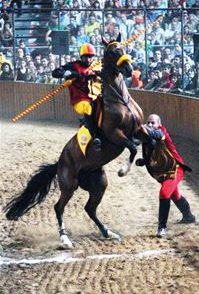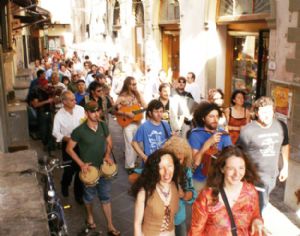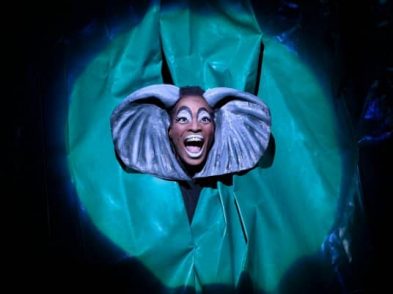Delightful
in all seasons, a trip on Tuscany’s oldest steam train line, La Porrettana, is
an unforgettable journey, meandering through the Apennine mountains, amid
stunning scenery, nature and nostalgia. Only on the Porrettana can you follow
in the footsteps of Sherlock Holmes, whom aficionados claim must have travelled
on this historic railway line on his journey from Switzerland to Florence after
defeating Moriaty at the Reichenbach Falls.
It was the first railway line
through the Apennines, connecting Italy’s northern and central regions. In 1858
Jean Louis Protche, a French engineer, was given the arduous task of planning a
link between Pistoia and Bologna. The main difficulty in constructing the line
was the 500-metre drop between Pracchia and Pistoia. Protche’s solution was a
spiral tunnel 2,727 metres long, between Piteccio and Corbezzi, known as the
Galleria dell’Appennino.
It turned out to be an amazing feat of engineering at the time. Work was
carried out with picks and shovels, explosives were rarely used. However, many
workers were killed in unpredictable landslides. Officially inaugurated on
November 3, 1864, the Porrettana line had 47 tunnels, 35 bridges and viaducts,
and covered a distance of 99 kilometres. Trains travelled at 20 kilometres per
hour and the journey took three and a half hours in those years.
Today, however, La Porretana is sadly under the threat of closure.
Initially, the railway suffered from problems with the weather, braking on
steep gradients and bad ventilation in the tunnels. Smoke not only caused
respiratory problems for passengers and drivers, but left film on the tracks,
making them slippery. As the train climbed away from Pistoia, teams of drivers
on horseback were stationed at the exit of the main tunnels, on call and ready
to take over from semi-asphyxiated drivers, whenever necessary.
In World War I, traffic on the line reached its peak, with up to 70
trains running each day. However, after the Direttissima line between Bologna
and Florence was opened in 1934, the Porrettana was relegated to handling local
traffic only. During World War II, the Germans blew up 29 bridges, 8 tunnels,
10 stations and 52 kilometres of train tracks. The damage was repaired
relatively quickly following the war: the Bologna-Pracchia line was reopened on
October 5, 1947, and the Pracchia-Pistoia line on May 29, 1949.
The most interesting part of the line is no doubt the section between
Pistoia and Porretta. Nowadays, trains on the one-track line run at no more
than 70 kilometres per hour and take about 50 minutes to cover the distance.
From Pistoia, the first two stations, Valdibrana and Piteccio, are now defunct.
Visible on the right, Valdibrana’s viaduct actually goes nowhere; it was built
as a safety device and counter-gradient to help stop the train. Piteccio’s
octagonal brick water reservoir can be glimpsed on the left.
Between tunnels, there are lovely views. On the left, after Corbezzi, is
the tiny pink station of Castagno, the smallest in Italy, which services an
average of nine passengers a day. Following San Mommè, is Pracchia, the largest
station and highest point on the line at 617 metres above sea level. The train
then follows the Reno river valley, where it crosses the Tuscany-Emilia Romagna
border five times before arriving at the charming station of Biagioni-Lagacci.
The penultimate stop is Molino del Pallone. Here you can visit the Parco
Naturale Sul Reno, which is especially pleasant in the summer. For a small
donation, you can make use of a sun-bed, bask riverside and take a dip. The
last stop is Porretta Terme, famous for its spas. This is where you change
trains to continue onwards to Bologna.
Considering its rich history, it is a real shame that the service has
been greatly reduced since February 2011. Buses have replaced 12 trains. The
Tuscan Region claims there are not enough passengers to make the line
economically viable. Moreover, the contract between the Tuscan region and
Trenitalia expires in 2014, causing more fears of closure. Luca Ceccobao, the
transport minister for the region, says that the line should not close and
further reductions in service are unacceptable. The folksinger Francesco
Guccini has been an active protestor. Having never had a driver’s licence, he
states that this line is vital to him and other mountain residents in similar,
high altitude locations.
An appeal is being made to UNESCO on behalf of the provinces of Pistoia
and Bologna to try to save this unique piece of national heritage. On April 3,
a press conference will be held in Bologna, officially launching the candidacy,
involving public institutions and representatives from both sides of the
mountain chain. Ideas to promote tourism include building an ‘ecomuseum’ in
Pistoia to recount the history of La Porrettana and its trains. School trips to
the various museums in the mountains are also being arranged, in addition to a
series of nine special tourist trains. The first is to be the Porrettana Noir
Express, inspired by Sherlock Holmes. A green-coloured train is being planned
for the summer, promoting folklore, sports activities and local products.
Personally, I have a deep fondness for La Porrettana. On my first
journey, a student of mine happened to be driving the train and invited me to
visit the cabin. While taking in spectacular upfront views of the Pistoia
mountains, he proudly recounted the line’s history and explained how the train
works. Arriving at Molino del Pallone, he offered me his seat and let me take
the wheel: I pressed down on the large accelerator pedal and pulled the brake
in Porretta, blowing the whistle all the way! It was better than the train set
I never had!
Here’s hoping that a solution will be found to save this regional-and
national-treasure. But buy a ticket soon, just in case.







